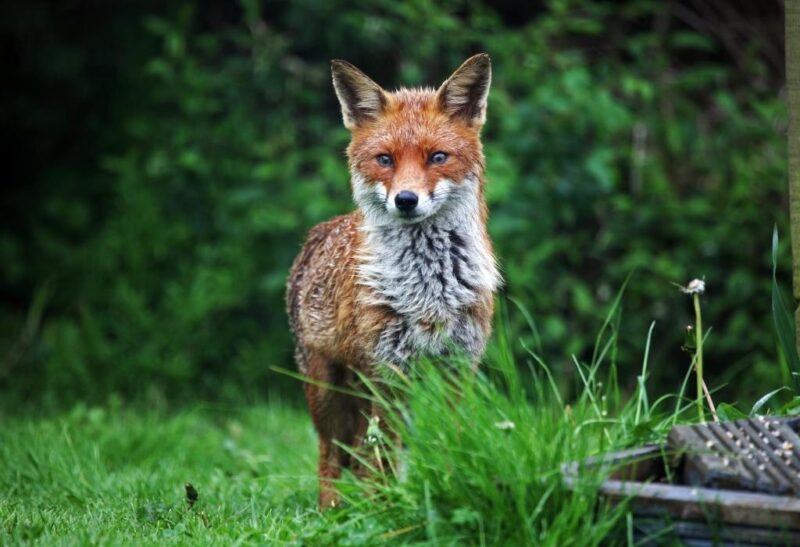Female foxes are among the most elegant of animals. They’re graceful, intelligent, and protective of their young, which makes them all the more fascinating. But, what exactly do you call a female fox?
A female fox is called a vixen. The term evolved from the Old English word for fox and is now used to represent powerful female figures. True enough, female foxes are smart, independent, and cunning – and the word “vixen” seems to sum up all of these perfectly.
But aside from its interesting etymology, how can you tell them apart from the male species? Are there striking differences between them?
Table of Contents
How Can You Tell a Male Fox From a Female Fox?

Perhaps the biggest tell-tale sign that identifies the male fox from the female fox is the size. Generally, female foxes are smaller by one-fifth compared to male foxes. This is true across a variety of fox species, although some male and female foxes are of the same size. That makes it hard to tell from a distance.
You can also look into the size and shape of the fox’s head. According to experts, a male fox has a broader head, while females have narrower ones. This gives vixens a more feminine appearance.
But while this is a great way to differentiate the males from the females during the summer, it gets hard during wintertime – when foxes grow thicker fur all over.
In terms of weight, males are also slightly heavier than vixens. But, this is only around 2 to 3 pounds, which isn’t much of a difference. While weighing pet foxes is a breeze, it may prove to be a challenge among wild foxes. Thus, the weight difference may not be the best indicator.
For those who are comfortable enough to get too close to foxes, you can also check out their teeth. Studies show that male foxes have larger teeth compared to females. However, checking the teeth of wild foxes can be quite risky.
What Are the Distinct Differences Between Male and Female Foxes?

To be more specific, the best way to distinguish between male and female foxes is to look at their genitals. This is the only way you can be a hundred percent sure.
Male foxes have a visible penile sheath on their lower belly. This is especially visible when in a sitting position or when they’re lying on their backs. This can be easy to observe for pet foxes but can be quite the challenge when you’re trying to spot wild foxes.
Another distinguishing physical attribute that only male foxes have are their testes. During the mating season, fox testes drop and tend to look bigger. In the summer, it looks smaller and lies higher on the dog fox’s behind, making it harder to see. Nevertheless, vixens do not have it, which makes them easy to spot whenever a group of foxes is nearby.
However, there are instances when male foxes get neutered. In this case, you won’t see any testes hanging from his behind, making it hard to determine a fox’s gender.
Another distinct difference is the engorged teats on a nursing fox. However, you can only see this when a vixen has already given birth to pups. You won’t be able to see them on younger vixens.
Aside from the genitals, you can also distinguish between male and female foxes through their behavior.
In general, males have more aggressive tendencies compared to females. They are also known to be more protective of their territories, often marking them with their urine. Also, if you happen to see a skulk of foxes on a hunt, there’s a big chance that they’re mostly male since females tend to stay with their pups.
Why Are Female Foxes Called Vixens?

Surprisingly, “vixen” simply evolved from the Old English term for fox. The feminine version of the word is “fyxe,” and is pronounced in Southern English countries as “fixen.”
This pronunciation has been adopted through the Middle English period, and the “f” sound eventually evolved to a more emphasized “v” sound. That’s how “vixen” came to be and is still used today.
Interestingly, the word “vixen” is among the rare feminine versions of Old English words that still exist in modern English. Now that’s a fact that’s worth remembering.
Are There Any Other Names for Female Foxes?

There are no other names for female foxes. While the males may either be called dogs, tods, or reynards, females stick to just one name – vixen. Even then, it seems like the name best describes the female fox species. No other name would seem appropriate to embody such a beautiful creature.
Are There Any Other Animals Known as Vixens?

There are no other known animals that are referred to as vixens. This is a testament to the uniqueness of female foxes.
However, the word vixen is often used to describe a human female who is cunning and wily. While this may seem like it’s giving off a negative connotation, some also use this word to describe a seductive, beautiful, or charming woman. It is synonymous with words like femme fatale and seductress.
How Can You Tell if a Dog Is a Fox or a Vixen?
As previously established, the best way for you to tell if a fox is a dog or a vixen is based on its genitals. If you can see a penile sheath or a pair of testes, it’s a dog. On the other hand, if you can see engorged teats, it’s a vixen.
But if you can’t go close enough to observe their genitals, you can also guess their gender based on their sizes. In general, the one with a larger build and a broad face is often a dog, while the one who looks smaller, with a narrow face is often a vixen.
Frequently Asked Questions
What Do You Call a Male Fox?
A male fox is usually called a dog or a dog fox. Other names for male foxes include tod and reynard.
Interestingly, “tod” is often used not to confuse foxes with dogs – another animal from the canine family. Like the word “vixen” or “fixen,” this is the Middle English term for a fox.
As for reynard, this is a nod to the popular medieval story about Reynard the Fox. There was a time that the story was so popular that “reynards” became synonymous with “foxes.” Even today, remnants of the name are present – especially in France, where the term for fox is “renard.”
What Is a Young/Baby Fox Called?
A young fox or baby fox may either be called a pup or a cub. There are also some instances when baby foxes are called kits. However, this is not used as often as pup or cub since it can also refer to baby rabbits or baby cats.
Related: Fox Babies Are Called Kits | All You Need to Know!
What Does a Female Fox Sound Like?
Female foxes are most notable for their high-pitched mating calls. This sound is often described as a hair-raising scream and often takes place in the middle of the night. Fortunately, these are only heard in January, which is considered the fox mating season.
But aside from this mating call, vixens are also known to produce throaty barks and purrs. These are the friendly sounds they make when they’re communicating or playing with other foxes. Although, these sounds aren’t as loud, so you can only hear them if you’re close enough to them – or if you have domesticated ones in your yard.
What Do Foxes Do After Their Mate Dies?
Interestingly, a male fox stays single forever once its mate dies. However, the opposite is true for the female fox. It has been observed that if a female fox loses its mate, she will simply find another mate. She will continue to produce new pups with her new mate and go on with her life.
What Color Are Female Foxes?
The color of a female fox primarily depends on the species of fox she belongs in. There are no color differences between male and female foxes.
One of the most popular fox colors is copper or reddish-brown, which is common among red foxes. Gray foxes are also common. As the name implies, they have abundantly gray fur across their body with a little bit of copper, blonde, or light brown under their necks and bellies.
Heading north, you will also find arctic foxes. These foxes are known for their slightly rounded ears and snow-white fur – which is true for both males and females.
There’s no denying that vixens are so aptly-named. They’re spirited, highly intelligent, and fiercely independent. They also make great mothers who take pride in rearing and protecting their young. They pounce with elegance and are generally more reserved than their aggressive male counterparts. With all these in mind, it’s easy to see why strong women are often called vixens.
List of Sources
Elischer, M. (2015). Animal adaptations for winter. Michigan State University Extension.
Learn about foxes. Commonwealth of Massachusetts.
Stephenson, B. (2008). Arctic Fox. Alaska Department of Fish and Game.
Gray Fox. Connecticut – Department of Energy and Environmental Protection.
